coolant temperature TOYOTA GT86 2017 1.G Owners Manual
[x] Cancel search | Manufacturer: TOYOTA, Model Year: 2017, Model line: GT86, Model: TOYOTA GT86 2017 1.GPages: 428, PDF Size: 7.83 MB
Page 158 of 428
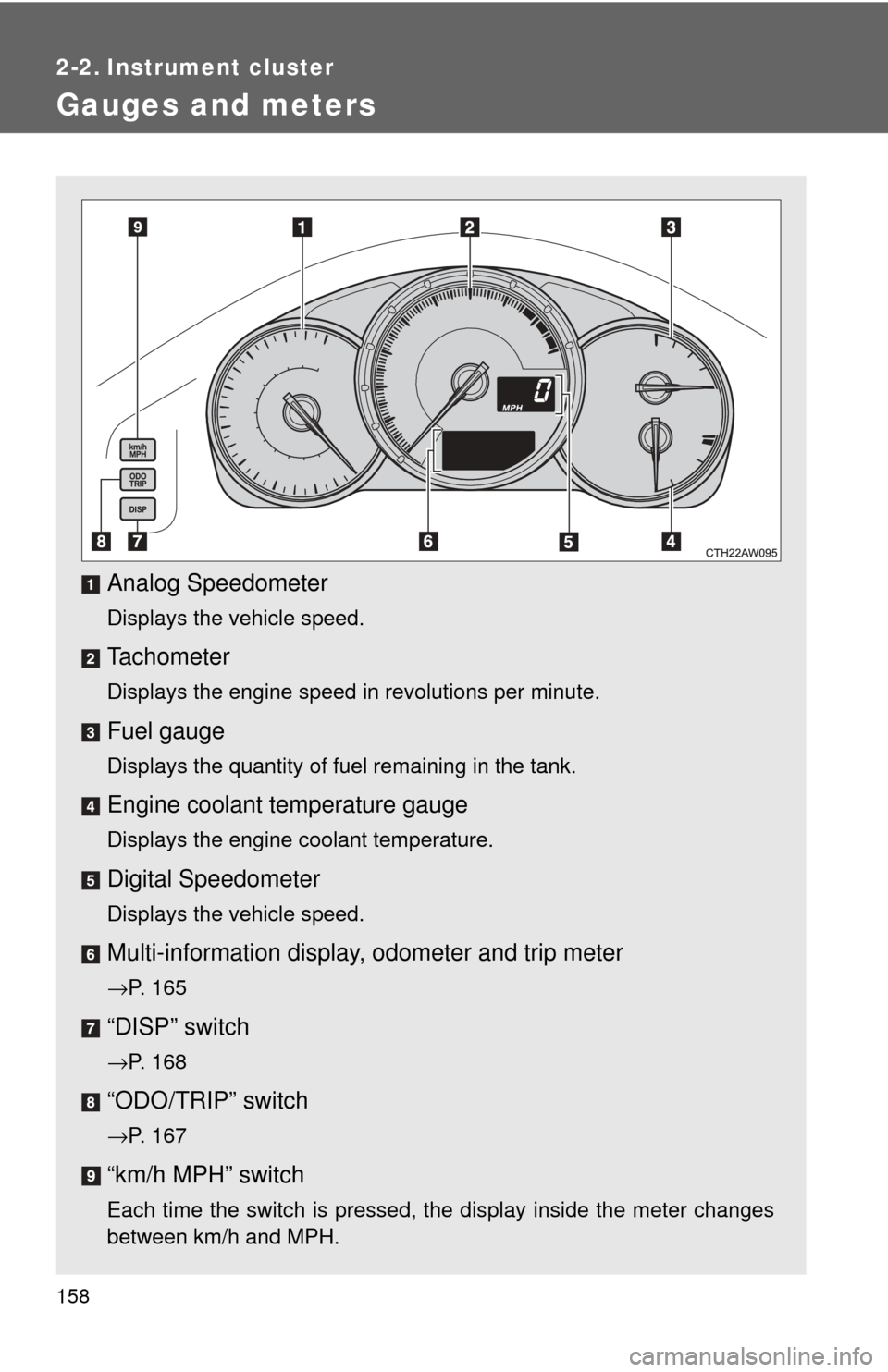
158
2-2. Instrument cluster
Gauges and meters
Analog Speedometer
Displays the vehicle speed.
Tachometer
Displays the engine speed in revolutions per minute.
Fuel gauge
Displays the quantity of fuel remaining in the tank.
Engine coolant temperature gauge
Displays the engine coolant temperature.
Digital Speedometer
Displays the vehicle speed.
Multi-information display, odometer and trip meter
→P. 165
“DISP” switch
→P. 168
“ODO/TRIP” switch
→P. 167
“km/h MPH” switch
Each time the switch is pressed, the display inside the meter changes
between km/h and MPH.
Page 252 of 428

252 4-3. Do-it-yourself maintenance
WARNING
The engine compartment contains many mechanisms and fluids that may
move suddenly, become hot, or become electrically energized. To avoid death
or serious injury, observe the following precautions.
■When working on the engine compartment
●Keep hands, clothing, and tools away from the moving fan and engine
drive belt.
● Be careful not to touch the engine, radiator, exhaust manifold, etc. right
after driving as they may be hot. Oil and other fluids may also be hot.
● Do not leave anything that may burn easily, such as paper or rags, in the
engine compartment.
● Do not smoke, cause sparks or expose an open flame to fuel or the bat-
tery. Fuel and battery fumes are flammable.
● Be extremely cautious when working on the battery. It contains poisonous
and corrosive sulfuric acid.
■ When working near the electric c ooling fans or radiator grille
Be sure the engine switch is off. With the engine switch in the “ON” position,
the electric cooling fans may automatically start to run if the air conditioning
is on and/or the coolant temperature is high. ( →P. 263)
■ Safety glasses
Wear safety glasses to prevent flying or falling material, fluid spray, etc. from
getting in the eyes.
NOTICE
■If you remove the air cleaner filter
Driving with the air cleaner filter removed may cause excessive engine wear
due to dirt in the air.
Page 315 of 428
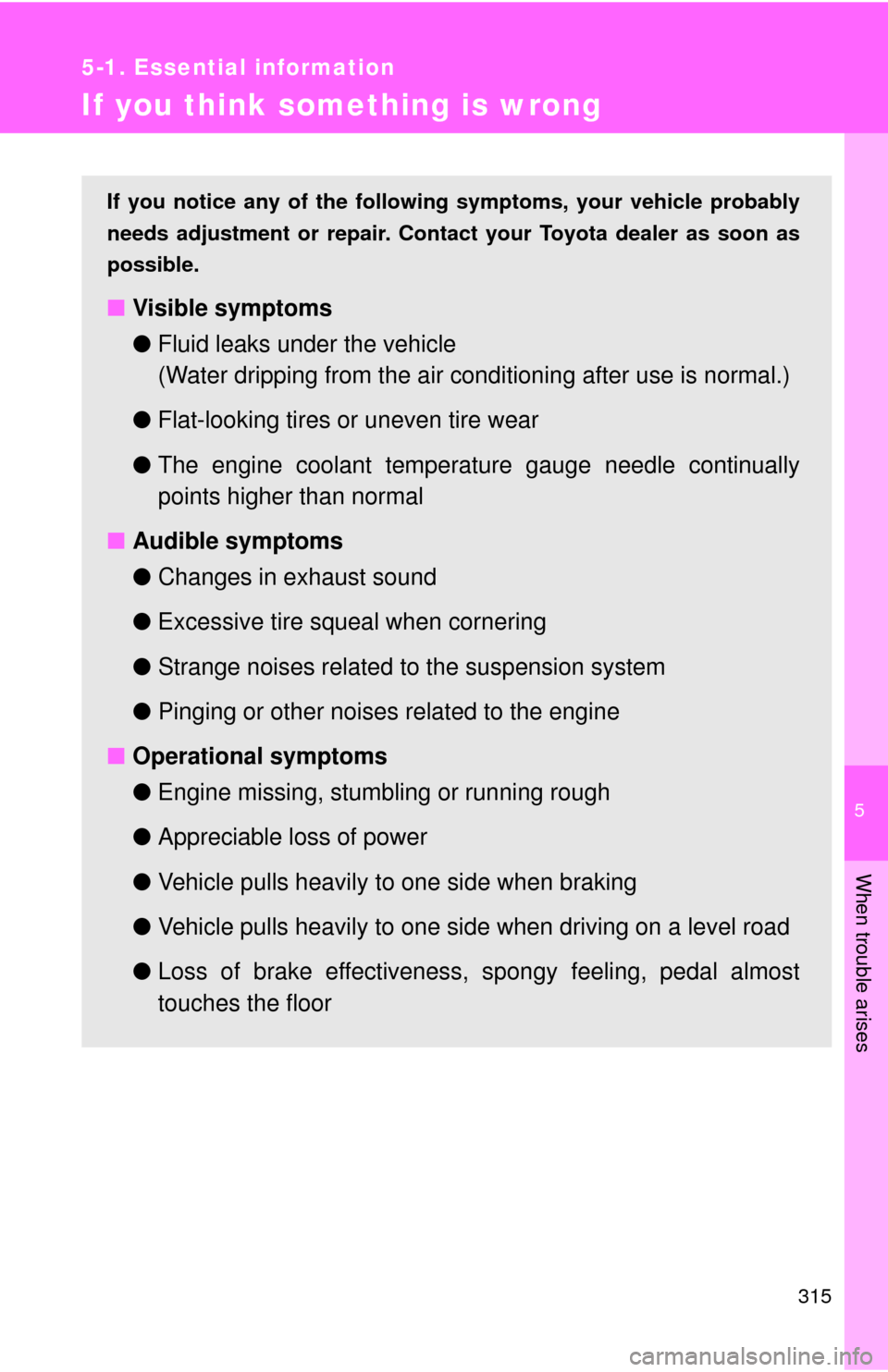
5
When trouble arises
315
5-1. Essential information
If you think something is wrong
If you notice any of the following symptoms, your vehicle probably
needs adjustment or repair. Contact your Toyota dealer as soon as
possible.
■ Visible symptoms
●Fluid leaks under the vehicle
(Water dripping from the air cond itioning after use is normal.)
● Flat-looking tires or uneven tire wear
● The engine coolant temperature gauge needle continually
points higher than normal
■ Audible symptoms
●Changes in exhaust sound
● Excessive tire squeal when cornering
● Strange noises related to the suspension system
● Pinging or other noises related to the engine
■ Operational symptoms
●Engine missing, stumbling or running rough
● Appreciable loss of power
● Vehicle pulls heavily to one side when braking
● Vehicle pulls heavily to one side when driving on a level road
● Loss of brake effectiveness, s pongy feeling, pedal almost
touches the floor
Page 345 of 428
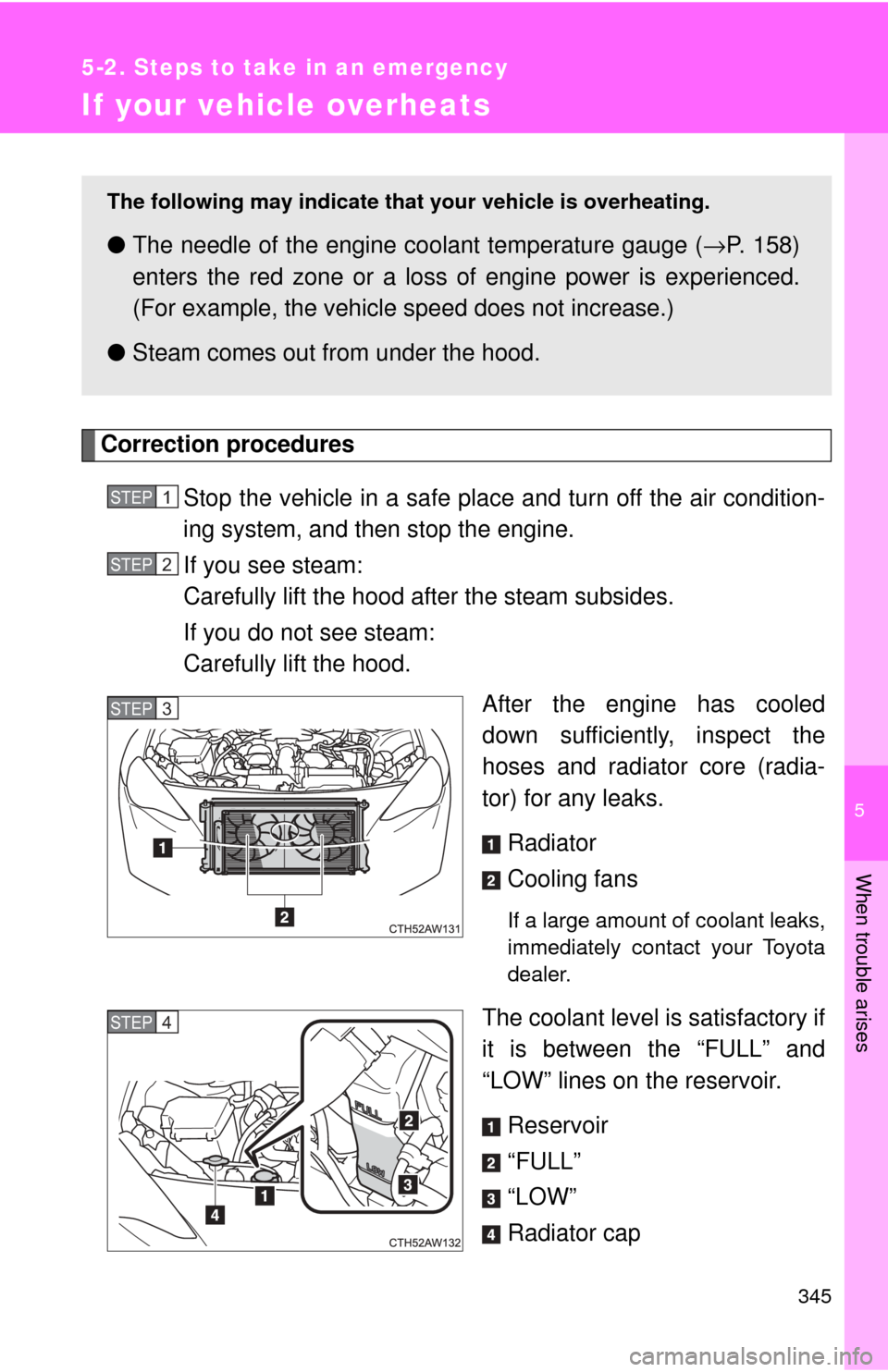
5
When trouble arises
345
5-2. Steps to take in an emergency
If your vehicle overheats
Correction proceduresStop the vehicle in a safe plac e and turn off the air condition-
ing system, and then stop the engine.
If you see steam:
Carefully lift the hood after the steam subsides.
If you do not see steam:
Carefully lift the hood.
After the engine has cooled
down sufficiently, inspect the
hoses and radiator core (radia-
tor) for any leaks.
Radiator
Cooling fans
If a large amount of coolant leaks,
immediately contact your Toyota
dealer.
The coolant level is satisfactory if
it is between the “FULL” and
“LOW” lines on the reservoir.Reservoir
“FULL”
“LOW”
Radiator cap
The following may indicate that your vehicle is overheating.
●The needle of the engine co olant temperature gauge (→P. 158)
enters the red zone or a loss of engine power is experienced.
(For example, the vehicl e speed does not increase.)
● Steam comes out from under the hood.
STEP 1
STEP 2
STEP 3
STEP 4
Page 346 of 428
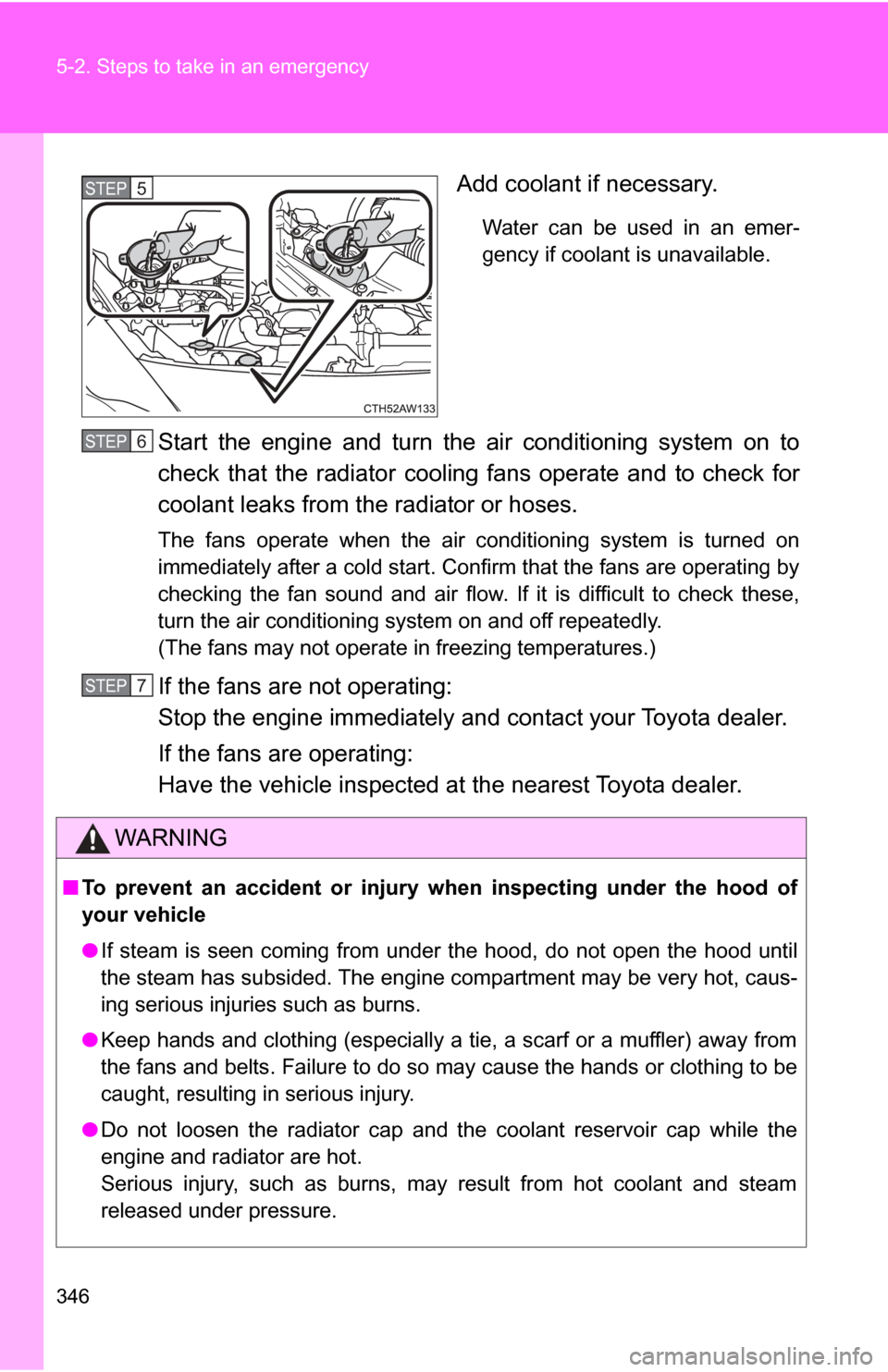
346 5-2. Steps to take in an emergency
Add coolant if necessary.
Water can be used in an emer-
gency if coolant is unavailable.
Start the engine and turn the air conditioning system on to
check that the radiator cooling fans operate and to check for
coolant leaks from the radiator or hoses.
The fans operate when the air conditioning system is turned on
immediately after a cold start. Confirm that the fans are operating by
checking the fan sound and air flow. If it is difficult to check these,
turn the air conditioning system on and off repeatedly.
(The fans may not operate in freezing temperatures.)
If the fans are not operating:
Stop the engine immediately and contact your Toyota dealer.
If the fans are operating:
Have the vehicle inspected at the nearest Toyota dealer.
STEP 5
WARNING
■To prevent an accident or injury when inspecting under the hood of
your vehicle
● If steam is seen coming from under the hood, do not open the hood until
the steam has subsided. The engine compartment may be very hot, caus-
ing serious injuries such as burns.
● Keep hands and clothing (especially a tie, a scarf or a muffler) away from
the fans and belts. Failure to do so may cause the hands or clothing to be
caught, resulting in serious injury.
● Do not loosen the radiator cap and the coolant reservoir cap while the
engine and radiator are hot.
Serious injury, such as burns, may result from hot coolant and steam
released under pressure.
STEP 6
STEP 7
Page 376 of 428

376 6-1. Specifications
Warning: The temperature grades of a tire assume that it is properly
inflated and not overloaded.
Excessive speed, underinflation, or excessive loading, either sepa-
rately or in combination, can cause heat buildup and possible tire fail-
ure.
Glossary of tire terminology
Tire related termMeaning
Cold tire inflation
pressure Tire pressure when the vehicle has been
parked for three hours or more, or has not
been driven more than 1 mile or 1.5 km under
that condition
Maximum inflation
pressure The maximum cold inflated
pressure to which a
tire may be inflated, s hown on the sidewall of
the tire
Recommended
inflation pressure Cold tire inflation pressure recommended by a
manufacturer.
Accessory weight The combined weight (in excess of those stan-
dard items which may be replaced) of auto-
matic transmission, power steering, power
brakes, power windows, power seats, radio
and heater, to the extent that these items are
available as factory-installed equipment
(whether installed or not)
Curb weight The weight of a motor vehicle with standard
equipment, including the maximum capacity of
fuel, oil and coolant, and if so equipped, air
conditioning and additional weight optional
engine
Maximum loaded
vehicle weight The sum of:
(a) Curb weight
(b) Accessory weight
(c) Vehicle capacity weight
(d) Production options weight
Page 418 of 428

418 Alphabetical index
Electric power steering ........... 184
Emergency flashersSwitch.................................... 306
Emergency, in case of If the engine will not start ...... 338
If the shift lever cannot
be shifted from P................. 339
If the vehicle has a
discharged battery .............. 341
If the warning buzzer sounds ................................ 317
If the warning light turns on ............................... 317
If you have a flat tire ............. 327
If you lose your keys ............. 340
If you think something is wrong .................................. 315
If your vehicle becomes stuck ................................... 348
If your vehicle has to be
stopped in an
emergency .......................... 350
If your vehicle needs to
be towed ............................. 307
If your vehicle overheats ....... 345 Engine
Compartment ........................ 257
Engine switch ........................ 142
Hood ..................................... 253
How to start the engine ......... 142
Identification number............. 355
If the engine will not start ...... 338
Ignition switch ....................... 142
Overheating .......................... 345
Engine coolant Capacity ................................ 360
Checking ............................... 261
Engine coolan t temperature
gauge ...................................... 158
Engine immobilizer system ...... 61
Engine oil Capacity ................................ 358
Checking ............................... 258
Preparing and checking before winter ....................... 200
Engine switch........................... 142
Engine switch light .................. 220
EPS............................................ 184
Event data recorder ................... 18E
Page 425 of 428
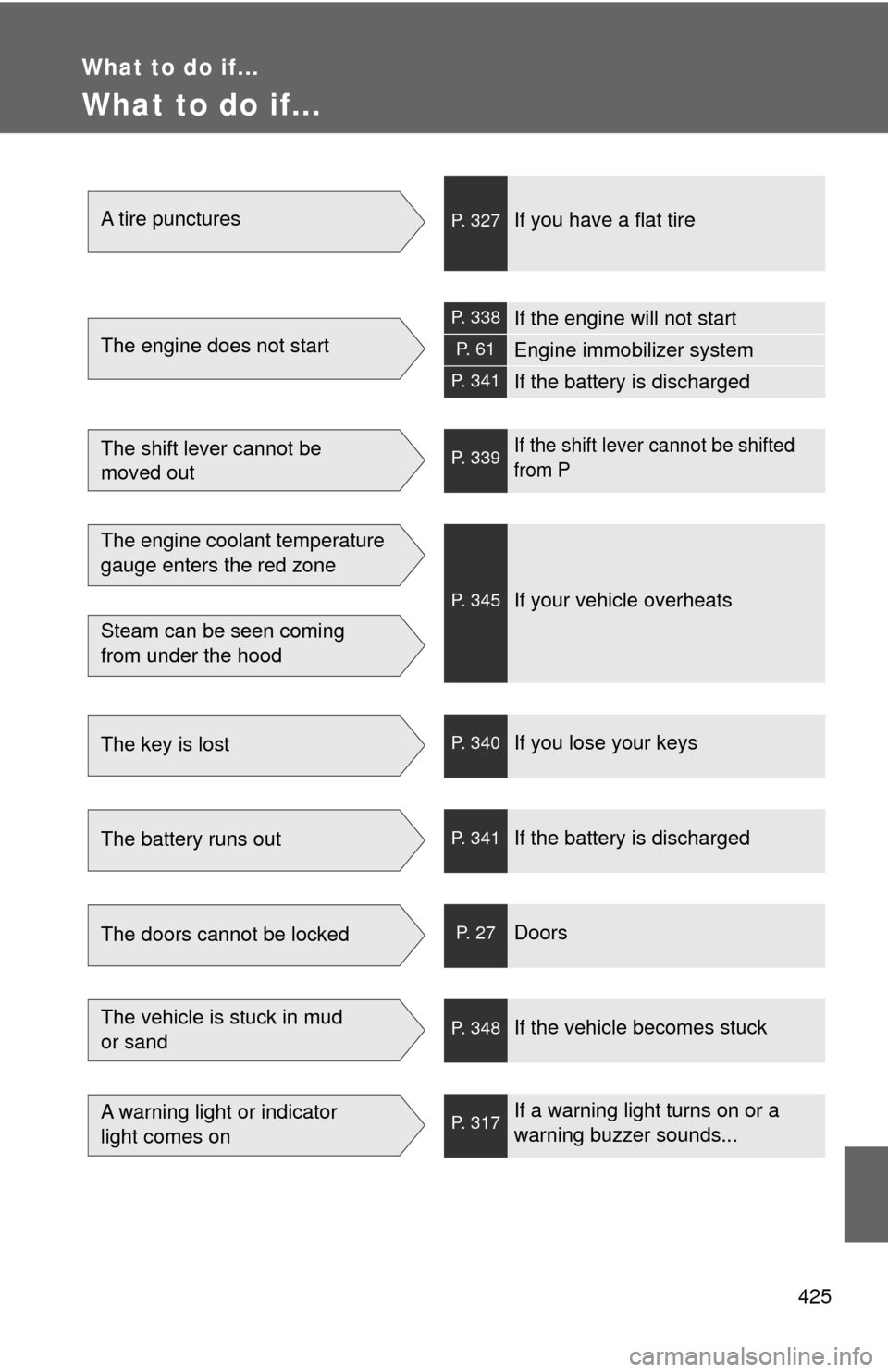
425
What to do if...
What to do if...
A tire puncturesP. 327If you have a flat tire
The engine does not start
P. 338If the engine will not start
P. 6 1Engine immobilizer system
P. 341If the battery is discharged
The shift lever cannot be
moved outP. 339If the shift lever cannot be shifted
from P
The engine coolant temperature
gauge enters the red zone
Steam can be seen coming
from under the hood
P. 345If your vehicle overheats
The key is lostP. 340If you lose your keys
The battery runs outP. 341If the battery is discharged
The doors cannot be lockedP. 2 7Doors
The vehicle is stuck in mud
or sandP. 348If the vehicle becomes stuck
A warning light or indicator
light comes onP. 317If a warning light turns on or a
warning buzzer sounds...